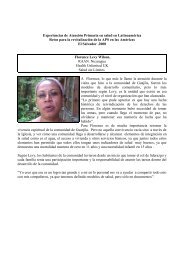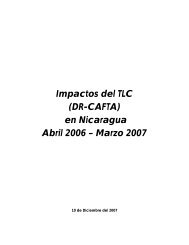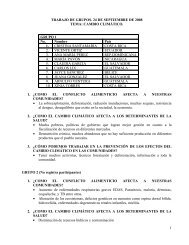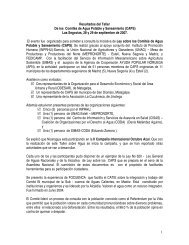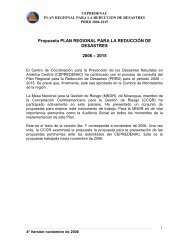A Gendered Analysis of the Social Protection Network in ... - CISAS
A Gendered Analysis of the Social Protection Network in ... - CISAS
A Gendered Analysis of the Social Protection Network in ... - CISAS
Create successful ePaper yourself
Turn your PDF publications into a flip-book with our unique Google optimized e-Paper software.
highlights that “gender-sensitive development strategies contribute significantly to<br />
economic growth as well as to equity objectives” (Bamberger et al 2001: 3 emphasis<br />
added).<br />
While not<strong>in</strong>g that equality should be a “development objective <strong>in</strong> its own right” (World<br />
Bank 2001b: 1) <strong>the</strong> newfound <strong>in</strong>terest <strong>in</strong> gender may <strong>the</strong>n be seen to have an ‘efficiency’<br />
ra<strong>the</strong>r than an ‘equity’ basis. This may result <strong>in</strong> an emphasis not only on economic<br />
growth ga<strong>in</strong>s, but on macro level economic ga<strong>in</strong>s. This means that <strong>the</strong> <strong>in</strong>dividual costs<br />
<strong>of</strong> such ga<strong>in</strong>s, and <strong>the</strong> extent to which such ga<strong>in</strong>s accrue to <strong>the</strong> <strong>in</strong>dividuals who have<br />
contributed to <strong>the</strong>m, are largely ignored. Such an approach may use women to ga<strong>in</strong><br />
macro level growth goals, while not improv<strong>in</strong>g women’s micro level situations, or while<br />
reduc<strong>in</strong>g <strong>the</strong>ir well be<strong>in</strong>g, as was <strong>the</strong> case with <strong>the</strong> Structural Adjustment Programmes <strong>of</strong><br />
<strong>the</strong> past (see Elson 1995). Even when women ga<strong>in</strong> f<strong>in</strong>ancially <strong>in</strong> this scenario <strong>the</strong><br />
narrow economic focus means that o<strong>the</strong>r possible costs may be ignored, as for example<br />
when women’s <strong>in</strong>comes <strong>in</strong>crease via waged labour <strong>in</strong> a factory that at <strong>the</strong> same time puts<br />
at risk <strong>the</strong>ir health. Accept<strong>in</strong>g that women’s relative poverty is experienced as social not<br />
just economic <strong>in</strong>equality means that an improvement <strong>in</strong> <strong>the</strong> economic situation does not<br />
necessarily br<strong>in</strong>g about a decl<strong>in</strong>e <strong>in</strong> ‘poverty’.<br />
A recent review <strong>of</strong> PRSPs (see Zuckerman 2001; 2002) notes a fur<strong>the</strong>r conceptual<br />
problem <strong>in</strong> that those PRSPs that have attempted to <strong>in</strong>clude gender have taken a Women<br />
<strong>in</strong> Development (WID) ra<strong>the</strong>r than a Gender and Development (GAD) approach. The<br />
WID approach sees <strong>the</strong> ‘problem’ <strong>of</strong> development for women is <strong>the</strong>ir exclusion from <strong>the</strong><br />
process (see Suanders 2002 for discussion). The proposed <strong>in</strong>clusion <strong>of</strong> women <strong>in</strong><br />
development has tended to focus on <strong>the</strong>ir <strong>in</strong>corporation <strong>in</strong>to education and formal sector<br />
employment. What WID does not do is critique <strong>the</strong> development process itself, see<strong>in</strong>g<br />
<strong>in</strong>clusion as hav<strong>in</strong>g purely positive ‘development’ outcomes. It also does not consider<br />
<strong>the</strong> underly<strong>in</strong>g reasons for women’s exclusion and as such <strong>the</strong> unequal power relations<br />
on which it is based rema<strong>in</strong> unchallenged. In contrast a GAD approach starts from an<br />
analysis <strong>of</strong> exist<strong>in</strong>g gender roles and relations and seeks to challenge <strong>the</strong>m.<br />
In terms <strong>of</strong> <strong>the</strong> Nicaraguan PRSP, no specific proposals around gender are <strong>in</strong>cluded <strong>in</strong><br />
<strong>the</strong> PRSP, but it does <strong>in</strong>clude specific references to women. Where mentioned, women<br />
are presented as mo<strong>the</strong>rs, <strong>in</strong> both <strong>the</strong>ir car<strong>in</strong>g and reproductive roles, and also as ‘victims’<br />
<strong>of</strong> male abandonment and violence. In contrast very little mention is made <strong>of</strong> women as<br />
producers and <strong>in</strong>come generators. Women’s fertility is also central with<strong>in</strong> <strong>the</strong><br />
Nicaraguan PRSP, s<strong>in</strong>ce population growth may effectively cancel out any economic<br />
growth ga<strong>in</strong>s. The focus not only places <strong>the</strong> responsibility for reproduction with <strong>the</strong><br />
woman alone, it also highlights <strong>the</strong> need for ‘responsible’ reproduction as targets such as<br />
improv<strong>in</strong>g access to family plann<strong>in</strong>g for ‘women with a partner’ suggests. Although<br />
women are <strong>the</strong> specific target <strong>of</strong> fertility programmes, more generally <strong>the</strong>y are <strong>in</strong>cluded <strong>in</strong><br />
<strong>the</strong> strategy as <strong>the</strong> means by which specific targets can be reached – <strong>the</strong> mechanism by<br />
which goods and services can be provided to <strong>the</strong> family and more specifically children.<br />
Civil society has been analys<strong>in</strong>g <strong>the</strong> PRSP process s<strong>in</strong>ce <strong>the</strong> beg<strong>in</strong>n<strong>in</strong>g (see CCER 2001;<br />
Quirós Víquez 2002). A gendered analysis <strong>of</strong> <strong>the</strong> PRSP process has also been on go<strong>in</strong>g<br />
and <strong>the</strong> shortcom<strong>in</strong>gs <strong>of</strong> <strong>the</strong> f<strong>in</strong>al policy document have been presented both nationally<br />
and <strong>in</strong>ternationally (see Quirós Víquez et al 2002). However, to date little attention has<br />
been paid to <strong>the</strong>se evaluations and pilot projects have gone ahead without tak<strong>in</strong>g <strong>in</strong>to<br />
account <strong>the</strong> concerns raised. The <strong>Social</strong> <strong>Protection</strong> <strong>Network</strong>, <strong>the</strong> key policy component<br />
<strong>of</strong> <strong>the</strong> social safety nets pillar, is a prime example <strong>of</strong> this.<br />
2





